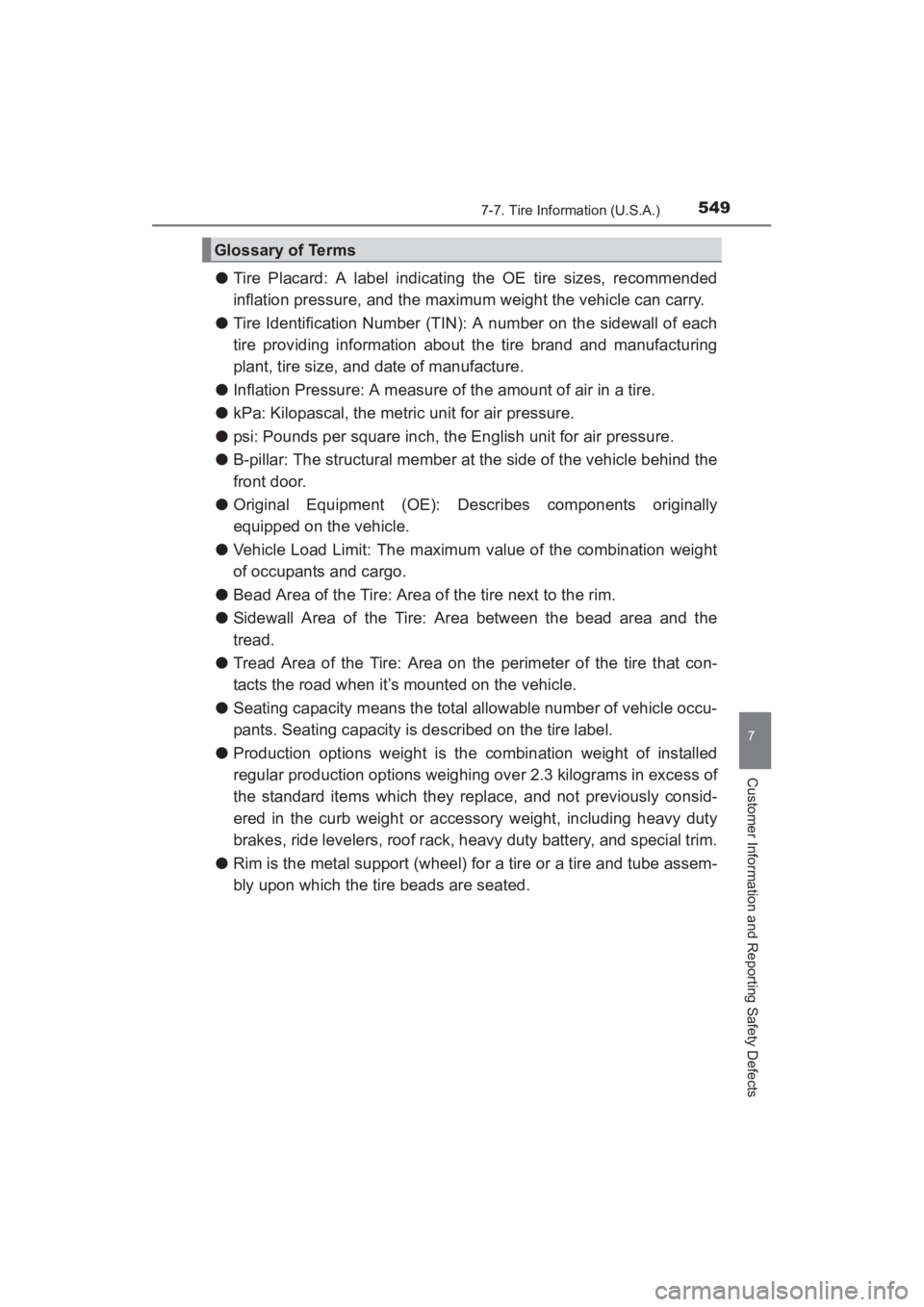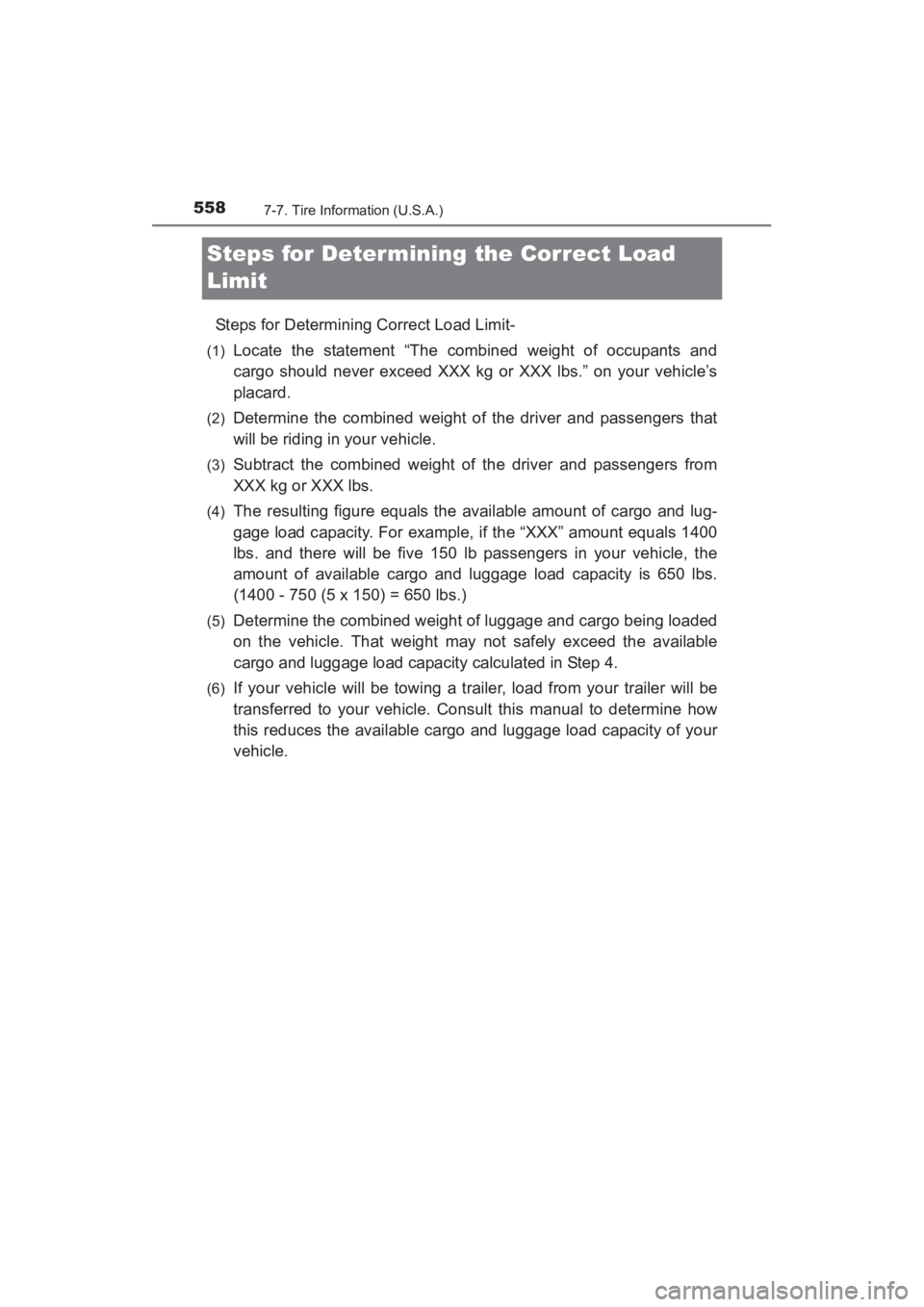load capacity TOYOTA YARIS 2016 Owners Manual
[x] Cancel search | Manufacturer: TOYOTA, Model Year: 2016, Model line: YARIS, Model: TOYOTA YARIS 2016Pages: 592, PDF Size: 10.44 MB
Page 551 of 592

YARIS_SEDAN_OM_OM99M18z_(U)
5497-7. Tire Information (U.S.A.)
7
Customer Information and Reporting Safety Defects
●Tire Placard: A label indicating the OE tire sizes, recommended
inflation pressure, and the maximum weight the vehicle can carry.
● Tire Identification Number (TIN): A number on the sidewall of each
tire providing information about the tire brand and manufacturing
plant, tire size, and date of manufacture.
● Inflation Pressure: A measure of the amount of air in a tire.
● kPa: Kilopascal, the metric unit for air pressure.
● psi: Pounds per square inch, the English unit for air pressure.
● B-pillar: The structural member at the side of the vehicle behind the
front door.
● Original Equipment (OE): Describes components originally
equipped on the vehicle.
● Vehicle Load Limit: The maximum value of the combination weight
of occupants and cargo.
● Bead Area of the Tire: Area of the tire next to the rim.
● Sidewall Area of the Tire: Area between the bead area and the
tread.
● Tread Area of the Tire: Area on the perimeter of the tire that con-
tacts the road when it’s mounted on the vehicle.
● Seating capacity means the total allowable number of vehicle occu-
pants. Seating capacity is described on the tire label.
● Production options weight is the combination weight of installed
regular production options weighing over 2.3 kilograms in excess of
the standard items which they replace, and not previously consid-
ered in the curb weight or accessory weight, including heavy duty
brakes, ride levelers, roof rack, heavy duty battery, and special trim.
● Rim is the metal support (wheel) for a tire or a tire and tube assem-
bly upon which the tire beads are seated.
Glossary of Terms
YARIS_SEDAN_OM_OM99M18z_(U).book Page 549 Monday, June 1, 2015 9:22 PM
Page 560 of 592

558
YARIS_SEDAN_OM_OM99M18z_(U)
7-7. Tire Information (U.S.A.)
Steps for Determining the Correct Load
Limit
Steps for Determining Correct Load Limit-
(1)Locate the statement “The combined weight of occupants and
cargo should never exceed XXX kg or XXX lbs.” on your vehicle’s
placard.
(2)Determine the combined weight of the driver and passengers that
will be riding in your vehicle.
(3)Subtract the combined weight of the driver and passengers from
XXX kg or XXX lbs.
(4)The resulting figure equals the available amount of cargo and lug-
gage load capacity. For example, if the “XXX” amount equals 1400
lbs. and there will be five 150 lb passengers in your vehicle, the
amount of available cargo and luggage load capacity is 650 lbs.
(1400 - 750 (5 x 150) = 650 lbs.)
(5)Determine the combined weight of luggage and cargo being loaded
on the vehicle. That weight may not safely exceed the available
cargo and luggage load capacity calculated in Step 4.
(6)If your vehicle will be towing a trailer, load from your trailer will be
transferred to your vehicle. Consult this manual to determine how
this reduces the available cargo and luggage load capacity of your
vehicle.
YARIS_SEDAN_OM_OM99M18z_(U).book Page 558 Monday, June 1, 2015 9:22 PM